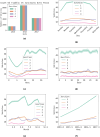Multi-objective federated learning traffic prediction in vehicular network for intelligent transportation system
- PMID: 40567762
- PMCID: PMC12192921
- DOI: 10.7717/peerj-cs.2922
Multi-objective federated learning traffic prediction in vehicular network for intelligent transportation system
Abstract
The spatial-temporal data of future freight traffic speed in the metropolitan region must be properly understood to develop freight-related traffic management strategies. This work introduces a new approach to traffic prediction using multi-objective federated learning. Instead of relying on a centralized cloud server for data processing, collaborative training is implemented among several participants. The proposed method utilizes the advantages of reinforcement learning in dynamic decision-making scenarios and the expressive capabilities of graphical models to identify traffic intensity. Furthermore, a new methodology integrates federated learning concepts with multi-objective optimization to forecast traffic patterns accurately. The proposed approach exhibits a higher level of performance than existing methods for estimating traffic speed. It achieves a communication delay of 23.4%, packet delivery ratio (PDR) of 92.45%, packet loss rate of 12.34%, prediction accuracy of 97.45%, and resource utilization of 89.56%. The visualisation findings demonstrate that this new approach is able to successfully capture interconnections of metropolitan areas in different neighboring cities.
Keywords: Federated learning; Intelligent transportation systems (ITS); Machine learning; Multi-objective optimization; Traffic prediction; Vehicular networks.
© 2025 Aalavanthar et al.
Conflict of interest statement
Stefano Cirillo is an Academic Editor for PeerJ Computer Science. Other than this, the authors declare that they have no competing interests.
Figures









Similar articles
-
Enhancing smart city sustainability with explainable federated learning for vehicular energy control.Sci Rep. 2025 Jul 4;15(1):23888. doi: 10.1038/s41598-025-07844-3. Sci Rep. 2025. PMID: 40615475 Free PMC article.
-
FedOpenHAR: Federated Multitask Transfer Learning for Sensor-Based Human Activity Recognition.J Comput Biol. 2025 Jun;32(6):558-572. doi: 10.1089/cmb.2024.0631. Epub 2025 Apr 23. J Comput Biol. 2025. PMID: 40267073
-
Health professionals' experience of teamwork education in acute hospital settings: a systematic review of qualitative literature.JBI Database System Rev Implement Rep. 2016 Apr;14(4):96-137. doi: 10.11124/JBISRIR-2016-1843. JBI Database System Rev Implement Rep. 2016. PMID: 27532314
-
Intelligent Priority-Aware Spectrum Access in 5G Vehicular IoT: A Reinforcement Learning Approach.Sensors (Basel). 2025 Jul 23;25(15):4554. doi: 10.3390/s25154554. Sensors (Basel). 2025. PMID: 40807721 Free PMC article.
-
Cost-effectiveness of using prognostic information to select women with breast cancer for adjuvant systemic therapy.Health Technol Assess. 2006 Sep;10(34):iii-iv, ix-xi, 1-204. doi: 10.3310/hta10340. Health Technol Assess. 2006. PMID: 16959170
References
-
- Abdellah AR, Alshahrani A, Muthanna A, Koucheryavy A. Performance estimation in v2x networks using deep learning-based m-estimator loss functions in the presence of outliers. Symmetry. 2021;13(11):2207. doi: 10.3390/sym13112207. - DOI
-
- Abdellah A, Koucheryavy A. Survey on artificial intelligence techniques in 5g networks. Telecom IT. 2020;8(1):1–10. doi: 10.31854/2307-1303-2020-8-1-1-10. - DOI
-
- Abdellah AR, Koucheryavy A. Artificial intelligence driven 5g and beyond networks. Telecom IT. 2022;10(2):1–13. doi: 10.31854/2307-1303-2022-10-2-1-13. - DOI
-
- Abubakar AI, Omeke KG, Ozturk M, Hussain S, Imran MA. The role of artificial intelligence driven 5g networks in covid-19 outbreak: opportunities, challenges, and future outlook. Frontiers in Communications and Networks. 2020;1:575065. doi: 10.3389/frcmn.2020.575065. - DOI
-
- Anisetti M, Bena N, Berto F, Jeon G. A devsecops-based assurance process for big data analytics. 2022 IEEE International Conference on Web Services (ICWS); Piscataway: IEEE; 2022. pp. 1–10.
LinkOut - more resources
Full Text Sources
